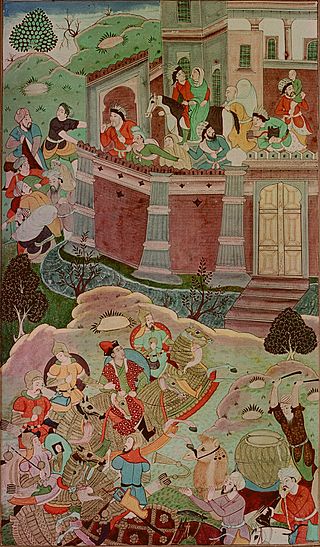
The Chagatai Khanate, or Chagatai Ulus was a Mongol and later Turkicized khanate that comprised the lands ruled by Chagatai Khan, second son of Genghis Khan, and his descendants and successors. At its height in the late 13th century the khanate extended from the Amu Darya south of the Aral Sea to the Altai Mountains in the border of modern-day Mongolia and China, roughly corresponding to the area once ruled by the Qara Khitai.

Kaidu was a grandson of the Mongol khagan Ögedei (1185–1241) and thus leader of the House of Ögedei and the de facto khan of the Chagatai Khanate, a division of the Mongol Empire. He ruled parts of modern-day Xinjiang and Central Asia during the 13th century, and actively opposed his uncle, Kublai, who established the Yuan dynasty. Medieval chroniclers often mistranslated Kadan as Kaidu, mistakenly placing Kaidu at the Battle of Legnica. Kadan was the brother of Güyük, and Kaidu's uncle.
Mubarak Shah was Khan of the Chagatai Khanate he was the son and successor of Qara Hülegü.

Alghu was a khan of the Chagatai Khanate (1260–1265/6). He was the son of Baidar and the grandson of Chagatai Khan.
Taliqu was Khan of the Chagatai Khanate (1308–1309). He was the son of Qadaqchi and a princess of Kerman, and a grandson of Büri. Following the death of Könchek, Taliqu seized power and became Khan. As a Muslim, he attempted to convert his subjects to Islam; this move was unpopular. This, combined with resentment that he was not a descendant of Duwa, led to a revolt against his rule. His enemies selected Duwa's son Kebek to become Khan, and defeated Taliqu in battle in 1309. His supporters joined the forces of Kebek, and were instrumental in defeating the sons of Kaidu that same year.
Buqa Temür was Khan of the Chagatai Khanate (1272?-1282). He was the son of Qadaqchi.
Duwa, also known as Du'a, was Khan of the Chagatai Khanate (1282–1307). He was the second son of Baraq. He was the longest reigning monarch of the Chagatayid Khanate and accepted the nominal supremacy of the Yuan dynasty as Great Khan before his death. Under his rule, the Chagatai Khanate reached its peak.
Esen Buqa I was Khan of the Chagatai Khanate. He was the son of Duwa.
Duwa Temür (Дуватөмөр) or Tore Temur (Төртөмөр) was Khan of the Chagatai Khanate for a period in 1329/1330. He was the son of Duwa.
Yasa'ur was a Chagatai prince who launched a revolt against the Ilkhan Abu Sa'id. He was the son of Chübei, and a great-great-grandson of Chagatai Khan.

Munkh Tumur or Möngke Temür was a son of Toqoqan Khan and Köchu Khatun of Oirat, daughter of Toralchi Küregen and granddaughter of Qutuqa Beki, and the grandson of Batu Khan. He was a khan of the Golden Horde, a division of the Mongol Empire in 1266–1280.

Moghulistan, also called the Moghul Khanate or the Eastern Chagatai Khanate, was a Mongol breakaway khanate of the Chagatai Khanate and a historical geographic area north of the Tengri Tagh mountain range, on the border of Central Asia and East Asia. That area today includes parts of Kazakhstan, Kyrgyzstan, and northwest Xinjiang, China. The khanate nominally ruled over the area from the mid-14th century until the late 17th century.
The Mongol Empire launched numerous invasions into the Indian subcontinent from 1221 to 1327, with many of the later raids made by the Qaraunas of Mongol origin. The Mongols occupied parts of the subcontinent for decades. As the Mongols progressed into the Indian hinterland and reached the outskirts of Delhi, the Delhi Sultanate of India led a campaign against them in which the Mongol army suffered serious defeats.
The Qara'unas or Negüderi were the Mongols who settled in Afghanistan after moving from Turkestan and Mongolia.

The House of Ögedei, sometimes called the Ögedeids, was an influential Mongol family and a branch of the Borjigin clan from the 12th to 14th centuries. They were descended from Ögedei, a son of Genghis Khan who succeeded his father to become the second khagan of the Mongol Empire. Ögedei continued the expansion of the Mongol Empire.

The Yuan dynasty in Inner Asia was the domination of the Yuan dynasty in Inner Asia in the 13th and the 14th centuries. The Borjigin rulers of the Yuan came from the Mongolian steppe, and the Mongols under Kublai Khan established the Yuan dynasty (1271–1368) based in Khanbaliq. The Yuan was a Chinese dynasty that incorporated many aspects of Mongol and Inner Asian political and military institutions.

The Kaidu–Kublai war was a war between Kaidu and Kublai from 1268 to 1301. Kaidu was the leader of the House of Ögedei and the de facto khan of the Chagatai Khanate, while Kublai was the founder of the Yuan dynasty. The Kaidu–Kublai war followed the Toluid Civil War (1260–1264) and resulted in the permanent division of the Mongol Empire. By the time of Kublai's death in 1294, the Mongol Empire had fractured into four separate polities: the Golden Horde khanate in the northwest, the Chagatai Khanate in the middle, the Ilkhanate in the southwest, and the Yuan dynasty in the east based in modern-day Beijing. Although Temür later made peace with the three western khanates in 1304 after Kaidu's death, the four successor states of the Mongol Empire continued their own separate development and fell at different times.

The Esen Buqa–Ayurbarwada war was a war between the Chagatai Khanate under Esen Buqa I and the Yuan dynasty under Ayurbarwada Buyantu Khan and its ally the Ilkhanate under Öljaitü. The war ended with the victory for the Yuan and the Ilkhanate, but the peace only came after the death of Esen Buqa in 1318.
In 1306, the Chagatai Khanate ruler Duwa sent an expedition to India, to avenge the Mongol defeat in 1305. The invading army included three contingents led by Kopek, Iqbalmand, and Tai-Bu. To check the invaders' advance, the Delhi Sultanate ruler Alauddin Khalji dispatched an army led by Malik Kafur, and supported by other generals such as Malik Tughluq. The Delhi army achieved a decisive victory, killing tens of thousands of the invaders. The Mongol captives were brought to Delhi, where they were either killed or sold into slavery.










